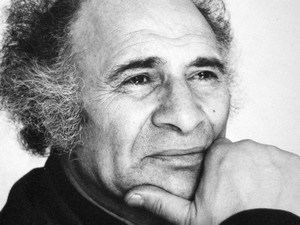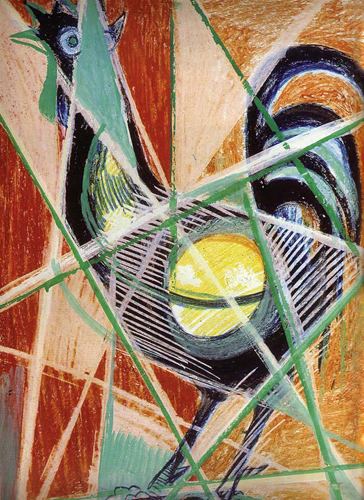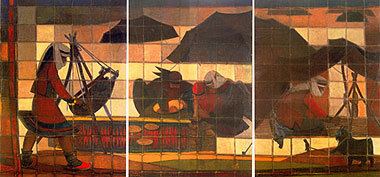Name Jalil Ziapour | Died 1999 | |
 | ||
In memory of Jalil Ziapour به یاد جلیل ضیاءپور
Jalil Ziapour (Persian: جلیل ضیاءپور; also Romanized as Jalīl Z̤iyāʼpūr) was an Iranian painter, academic member, Researcher and writer mentioned as "the father of modern Iranian painting". Besides having been a leading painter and the head of the futuristic movement, he has had many research activities in the fields of anthropology, study and familiarization with language, public culture, clothing and decorative designs of different regions of Iran, and their results are currently used in universities as reference books. During his cultural and artistic activity, Ziapour has performed giving more than 85 lectures, presenting more than 70 cultural and artistic articles, writing more than 28 books in the fields of Iranian clothing, art and history and also creating about 40 paintings and two statues. He was one of the founders of the artistic Fighting Cock Society.
Contents
Biography

Jalil Ziapour was born in Bandar-e Anzali on 1920. His childhood hobbies were forming statues from Anzali marshes mud and listening to music. He began his art studies since youth. After finishing primary education, he went to Tehran in 1938 and entered the Music School, which was directed by Mr. Minbashian then, for composing and passed the entrance tests; but at that time, the foreign professors of the school returned to their home countries and he was not able to follow his agenda. Therefore, he started studying and familiarizing with traditional arts in the School of Fine Arts. In 1941, he entered the Beautiful Arts School. The first period of the school (1941–1945) announced three graduates in painting and Ziapour received the first place and the first class cultural medal from the school and headed to France by the scholarship presented by that country's government and continued studying in École nationale supérieure des Beaux-Arts in visual arts field.

In 1948, after his first return to Iran, the academy painters including Javad Hamidi, Hossein Kazemi,... assembled and the remarkable activity of contemporary painting in Iran was established. In 1949, Ziapour established the artistic board "Fighting Cock", which was a leading committee in the field of modern arts in literature, theater, music and painting, and started printing a magazine with the same name with his proponents and presented his theory about visual arts (painting) called "Refute of the Theories of Past and Contemporary Ideologies -from Primitive to Surrealism". During his artistic activity as a painter, he was always considered as the leader of futurism and the developer of modern art and is the initiator of artistic criticism in Iran. Ziapour contended in four fronts: the followers of past methods, the degenerate modernists who had returned from abroad, the mass traditionalists, the followers of the old European method. His effort was to preserve the Iranian identity by leaning on the capacity of native culture, but speak by a global tongue and present it and eventually bring honor to his Iranian culture.

In 1952, he was offered a job from the National General Agency of Beautiful Arts and performed many cultural-artistic activities, jobs and missions like founding the female and male high schools for visual arts, decorative arts school, dean of anthropology museum, etc. In 1979, he retired from public service and since then until his final days of life, he performed research, writing and teaching at the schools of dramatic and decorative arts, Islamic Art Collective, Tarbiat Modares and Al-Zahra Universities. In 79 years of age, Ziapour died at the Tus hospital of Tehran on Tuesday, December 21, 1999, as a result of heart failure after spending a difficult period of disease, and two days later on December 23, he was buried at the artists section of Behesht-e Zahra.
Fighting Cock Society

After his first return to Iran (1949), he founded the artistic society of Fighting Cock, which was a leading society in the fields of modern art about literature, theater, music and painting, and also started printing a magazine with the same name. The location of the society was the Ziapour Atelier at the Takht-e Jamshid Avenue. He announced the goal of the Fighting Cock Society "Contending Conservatism and Traditionalism far from the Realities of the Time" and picked a poem by Farrukhi Sistani as the motto of the society:

فسانه گشت و کهن شد حدیث اسکندر/ سخن نو آر که نو را حلاوتی است دگر

Meaning: The tale of Alexander became a legend and an old one. State new words which have a different sweet taste.
Eventually, the opponents, who had introduced the Fighting Cock Magazine a publication associated with the Tudeh Party and believed cubism equal to communism, caused Ziapour's interrogation at the Official Misdemeanors Court and the banning of the magazine. Then be published another magazine titled "Kavir", which was also banned, and then continued reflecting his thoughts at the publication "Claw of Cock".
Theory
Ziapour presented his art theory and view as a thesis titled "Refute of the Theories of Past and Contemporary Ideologies from Primitive to Surrealism" in October 1948 to cultural and journal societies; and in it, after presenting a short history of Occidental art ideologies, he considered all those ideologies ineffective for the main goal of painting and stated most of them as covers for supplying things other than painting. By that thesis, he became very close to the definition of single and abstract painting and looked at the material of modern painting, whose cleansing from literary, historical, social and so on is necessary in order to achieve an independent function of color, line, light and creative compositions. The general conclusions stated in the theory are:
- The color and design are types of a far abnormal form and composition that the painting should act based on.
- The more abnormal the concept in the painting is from the aspect of organization, the more complete and valuable from the aspect of specialty it is.
- The concept of the painting, should not present the subject, the phrase and the result "like normal writings"; since every line and color, every form and every composition, is by itself possessing the subject and phrase and result and subsequently the concept; therefor, any form and picture and concept inclined to the familiar nature is contradictory with the profession of painting.
- The more the natural and close unnatural pictures are replaced by combinations of color and design and other professional factors, the more the painting progresses towards perfection, where it can earn its beauties and individual pleasures further.
- If the painting contains natural or close unnatural pictures, the artist should deliberately destroy them so that it becomes dissimilar to the normal nature in order to show the artistic factors completely and without any parasites.
- In painting without a picture, which means outside natural and close unnatural pictures, the artist understands their own assignment and knows that they should directly perform artistic factors, i.e. forming more accurate and pleasant synchronizations and more lively and meaningful designs, in order to make specialized beauties. In this stage, both the artist and the public, especially those who "believed to have understood specialized beauty by realizing normal and visual concepts like their own memories and wishes", understand their assignments; and from now on, they refer directly to artistic factors in order to understand the beauty of the painting, not to the visual concepts or the picture itself. That will be the first stage where the artist and the public both find out the truth about specialized beauty or specialized aesthetics.
- Until now, painting has not reached its limits of specialized art and beauty and has had a very close interaction with other beautiful arts especially the literature of "descriptive events". By applying this theory, an ideology which we call "perfect" is born that separates the limits and borders of painting from other arts. This place, i.e. "the perfect ideology", will be the true home of professional and specialized painting- apart from other arts; and from here, painting will show itself with a more extensive concept.
- The beauty of painting is different from that of other fine arts, and should be inspected separately.
- It should be noted that no new method is ever born without the required environment; and no request can ever be ahead of the current request of its time; because every request has a factor; and surely the main factor of any motivated request in the society has a requester. Therefor, my theory is not outside the demand of my current time and can not be.
Works
Ziapour's works are famous because of possessing original Iranian concepts, simplification of figures, loyalty to the traditional levels along with geometric lines of cubism, awareness of composition and generally the special style of painting. His research trip to Kavir and various Iranian regions for anthropological inspections, guided his attention towards nomadic lifestyle. He saw their behaviors, customs and traditions, clothes and adornments worth noticing and utilized those resources in his works and because of his research inclination toward farming lifestyle, nomadic concepts appeared in his works in an allegorical way.
Journalistic illustrations, researches on Iran and cultural and educational activities left him less time for creating more works.
